Punjab State Board PSEB 10th Class Physical Education Book Solutions Chapter 2 Balanced Diet Textbook Exercise Questions and Answers.
PSEB Solutions for Class 10 Physical Education Chapter 2 Balanced Diet
Very Short Answer Type Questions
Question 1.
What are the various functions of the Food?
Answer:
Whatever the food we take, it performs so many functions after digestion and absorption. The functions of foods are as under:
1. It helps for the growth and development of the body. Food helps us in the development of the various organs of our body.
2. Provide strength. It gives us the strength to do various activities. To perform these activities the power comes from the food.
3. Produce energy in our bodies. When the food after absorption mixes with the oxygen which we inhale, produces energy in our body. This energy is very necessary for us. We cannot live without energy.
4. Construct new cells and repair old ones. Food repairs the broken cells and also produces new cells due to the activities of our body. So many cells destroy and much of them are broken. It is the food which creates new cells.
5. Prevent diseases. Food is to human-machine what petrol is to an automobile. It creates strength in our body which enables us to fight against diseases
Question 2.
What is food? Why we take food?
Answer:
Food is such type of material which produces blood in our body.
- Formation of new cells.
- Food supplies energy to body.
- Food supplies heat to body.
- Food helps in growth and development of body.
PSEB 10th Class Physical Education Book Chapter 2 Balanced Diet
![]()
Question 3.
What are vitamins? Why are vitamins needed for our body?
Answer:
Vitamins are such chemical materials which help our body for proper growth and development. By now many vitamins have been discovered but the most prominent of all these are vitamins A, B, C, D and K.
Need of Vitamins to Our Body:
- Vitamins maintain our health.
- Vitamins help in the growth and development of our body.
- Vitamins increase appetite.
- Vitamins purify our blood and increase blood in our body.
- Vitamins strengthen the bones and teeth.
- Vitamins help us to create immunity in our body.
- Vitamins cure the skin diseases.
- Vitamins provide energy to our body.
Question 4.
What is Calorie?
Answer:
Calorie. The smallest unit to measure food constituents is called a calorie.
Short Answer Type Questions
Question 1.
What are various types of vitamins? Describe their functions and their sources.Write down the sources and advantages of the following vitamins A, B, C, D and K.
Answer:
Vitamins. By now many vitamins have been discovered, but the most prominent of all these are vitamins A, B, C, D, E and K. The details about the sources and functions of various vitamins have been given below:
1. Vitamin A:
The following are the functions of vitamin A:
- It improves eyesight.
- It increases appetite.
- It keeps digestive function normal.
- It helps in the development and strengthening of body.
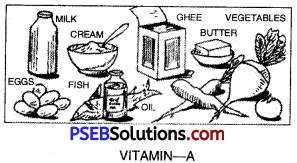
Harms due to Lack of Vitamin A:
- The lack of vitamin A causes night blindness.
- The skin becomes dry.
- Nose, throat, eyes and skin become more prone to infectious diseases.
- The body becomes weak and its development stops.
- The lungs get weakened.
Sources:
It is available in plenty in milk, curd, butter, cheese, egg, fish, fresh vegetables such as spinach, carrot, cabbage and tomato, orange, mango, papaya, fig, etc.
2. Vitamin B:
The following are the functions of vitamin B:
- It regulates Nervous System and keeps it normal.
- It energizes nerves, muscles, heart and brain.
- It stimulates appetite.
- It gives protection against skin diseases.
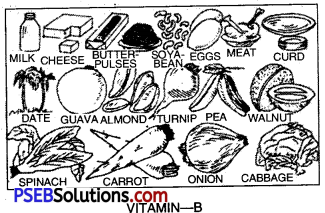
Harms due to Lack of Vitamin B:
- One feels less appetite.
- The development of children stops.
- One is afflicted with a disease called beri-beri and skin diseases.
- One develops blisters on the tongue.
- The hair begins to fall off.
Sources:
It is available in milk, curd, butter,cheese, whole pulses, cereals, soyabean, peas, eggs, leaves of green vegetables, cabbage, onion, spinach, tomato, salad, etc.
3. Vitamin C:
The functions of vitamin C are:
- It purifies the blood.
- It strengthens teeth.
- It helps in the % rapid recovery of fractured bones.
- It protects the body against diseases.
- It saves throat from several diseases.
- It protects one from bad cold, etc.
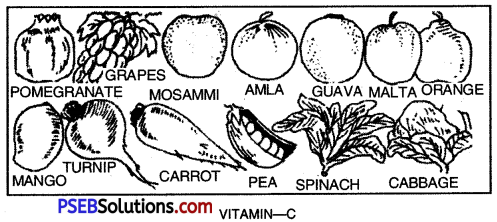
Harms due to Lack of Vitamin C:
- One is afflicted with such teeth diseases as pyorrhoea.
- The bones get weakened.
- Wounds do not heal quickly.
- One suffers from anaemia.
- Bleeding does not stop quickly.
Sources:
It is found in orange, lemon, malta, pomegranate, guava, amla, etc. In addition to these, it is available in green vegetables, tomato, cabbage, carrot, spinach, etc. ,
4. Vitamin D:
The functions of vitamin D are :
1. It helps in the formation of bones and teeth.
2. It strengthens bones and teeth.
3. It is needed most for the growth of children. Vitamin D we get from sun.
Sources
It is found in milk, egg yolk, butter, ghee, cod liver oil, etc. It forms itself in the rays of the sun.

Harms due to Lack of Vitamin D:
- Bones become weak.
- The teething of childern gets delayed.
- One is afflicted with such diseases as epilepsy, hysteria and rickets.
- Muscles become weak.
5. Vitamin E:
The functions of vitamin E are
- It increases the reproduction power.
- It prevents impotency in men and infertility in women.
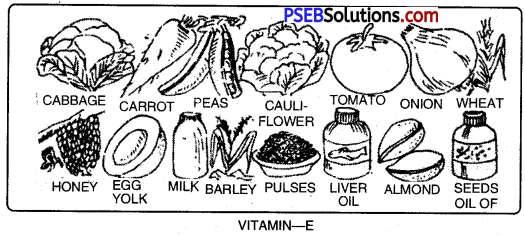
Harms due to lack of Vitamin E:
- Boils are formed on the skin.
- One is afflicted with infertility
Sources:
It is available in cabbage, carrot, salad, peas, onion, tomato, cauliflower. In addition to these, it is found in honey, wheat, rice, egg yolk, almond, pistachis, gram pulse, etc.
6. Vitamin K:
The functions of Vitamin K are as follows:
- It stops blood flow from cuts.
- It helps in blood clotting.
- It saves one from skin diseases.

Harms due to lack of Vitamin K:
- The process of blood clotting gets stopped.
- One is afflicted with some skin diseases.
Sources: It is found in cabbage, spinach, fish, soyabean, tomato and egg yolk.
![]()
Question 2.
Why carbohydrates and Fats are essential for us?
Answer:
Carbohydrates:
Carbohydrates provide heat and energy to the body. Indians, in general, compensate 70-80% of their food with this compound.
Sources:
Carbohydrates are available in wheat, rice, barley, maize, millet, jaggery, sugar, potatoes, etc.
Advantages of Carbohydrates.
- Carbohydrates provide heat and energy to the body.
- They help in digesting fat.
- They cleanse intestines and liver.
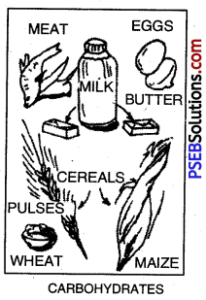
Harms Due to Lack of Carbohydrates:
- As a result of the lack of Carbohydrates, blood loses its alkaline nature, and becomes more acidic. In such a condition, a person may become unconscious. In such a condition due to hunger one may get diabetes.
- Intestines are not cleaned properly.
- As a result of lack of carbohydrates, fats remain undigested in the body.
- As a result of lack of carbohydrates acidic elements in the liver get cleansed, and it is harmful to the body.
- A person becomes very weak and may die in case there is excess or lack of carbohydrates in his food.
Harms due to Excess of Carbohydrates. The excess of carbohydrates causes:
- fatness
- high blood pressure
- joint pains and
- diabetes.
Proper Quantity. Our food has 50-80% of carbohydrates. 50-60% part of balanced diet consists of carbohydrates. A normal person should have 400 to 700 gms. of carbohydrates in his daily food.
Fats – Fats are of two types:
1. vegetable fats
2. animal fats
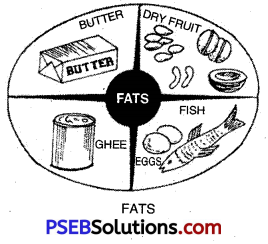
Sources:
- Vegetable Fats. These are available in almonds, walnuts, soyabeans, groundnuts, coconut oil, mustard, etc.
- Animal Fats. These are available in ghee, butter, milk, meat, fish, egg, etc.
Advantages:
- It provides energy to the body.
- It keeps the body temperature stable.
- It protects all parts of the body against external injuries.
- It keeps in reserve vitamins A, D and K according to the needs of the body.
Harms due to the Lack of Fats:
The body suffers in the following ways in case there is lack of fats :
- Skin becomes dry.
- The deficiency of vitamins A, D and K follows.
- The skin goes dry because of the lack of acids of fat.
Harms due to the Excess of Fats:
The excess of fats in one’s food also proves to be harmful in the following ways:
- One suffers from obesity.
- Heart diseases are caused.
- Digestion weakens.
- One suffers from diabetes.
- Stones may form in the abdomen.
Proper Quantity:
A normal person should have 50 to 75 gms of fats in his daily food.
![]()
Question 3.
Why different mineral salts are necessary for our body?
Answer:
Mineral Salts. Our body has 4% of minerals and salts. Phosphorus, calcium, sodium, chlorine, potassium, magnesium
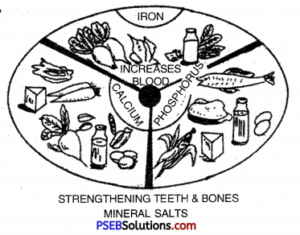
Sources:
Minerals and salts are available in green vegetables, green fruit, meat, milk. Milk has less amount of iron, but it has all other minerals.
Advantages
- Minerals strengthen our teeth and bones.
- They help in the development of muscular tissues.
- They make the blood red.
- Calcium helps in blood clotting,
- Minerals help in the proper functioning of all parts of the body.
Harms due to Lack of Minerals:
- The lack of calcium causesthe weakening of teeth and bones.
- Body loses its power of resistance to diseases.
- The lack of iodine is the cause of goitre in the body.
1. Calcium and Phosphorus:
These minerals are found in abundance in milk, curd, cheese, eggs, fish, meat, vegetables, fresh fruit, pulses, almonds, etc. They are helpful in the growth of body. They help in formation of teeth and bones. The are useful to heart and brain.
2. Iron:
Iron is available mostly in green vegetables, fruit, cereals, eggs and meat. It helps in producing new iron and stimulates hunger. It cleanses blood.
3. Sodium:
It is generally available in lady fingers, fig, coconut, salt, radish, carrot, turnip, etc. It removes many diseases of stomach and kidneys.
4. Potassium:
It is available in pear, coconut, lemon, fig, cabbage, radish, etc. It nourishes liver and heart, and removes constipation.
5. Iodine:
It is availablein sea fish, sea salt, onion, garlic, tomato, apple, spinach, carrot and milk, etc. It gives energy and increases body weight. Lack of Iodine cause Goitre disease.
6. Magnesium:
It is available mostly in orange, fig, tomato, wheat, spinach, malta, etc. It prevents skin diseases and strengthens muscle’s.
7. Sulphur:
It is available in plenty in onion, radish, cabbage, cauliflower. It helps in increase of nails and hair. It cleanses skin.
8. Chlorine:
It is available in plenty in onion, spinach, radish, carrot, cabbage and tomato. It excretes waste products from the body. It cleanses the body.
![]()
Question 4.
Write a note on the following :
A. Balanced diet
B. Proteins
C. Water
Answer:
A. Balanced Diet:
Food, nutritious elements, the need of food, all relate to nutrition. The science deals with our food, its related customs, traditions and our mental attitude or feelings.Balanced Diet. Balanced diet is the diet which has all the nutrients in right proportion, and which is capable of fulfilling all the needs of the body.
It should have all nutrients like carbohydrates, proteins, fats, vitamins, minerals, salts and water in proper proportion. Such a diet needs to be taken for the proper development of body, protection from diseases and good health. No single item of food is balanced diet in itself. Only milk is an exception, as it has got almost all nutrients.
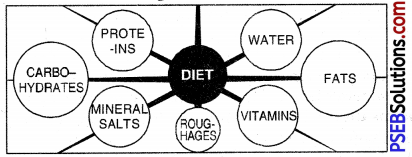
B. Proteins:
Proteins. Protein is a complex compound consisting of carbon, hydrogen, oxygen, sulphur, phosphorus and nitrogen. It is of two kinds-vegetable protein and animal protein.
Sources
- Vegetable Protein-It is availably in soyabeans, groundnuts, cashew-nuts, pistachio, walnuts, wheat, millet, maize, etc.
- Animal Protein-It is available in meat, fish, egg, cheese, etc.
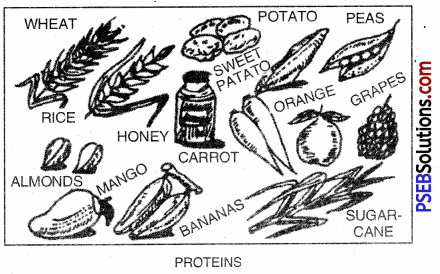
Advantages of Protein:
- It ensures physical growth and development
- It repairs broken tissues
- It keeps the body temperature normal
- It produces energy in case there is lack of the quantity of carbohydrates or fats in the body.
Harms due to lack of Proteins:
The body catches the following diseases due to lack of proteins:
1. Kwashiorkor:
This disease is common in children in the age group of 1-3 years in case there is lack of proteins. At first, the child’s legs are affected. Then this disease causes swelling on his face and then the whole body. The skin of the child becomes rough and red. The child becomes irritated.
2. Rickets or Rachitis:
As a result of the lack of proteins children suffer from rachitis. A child affected with this disease looks very thin and weak. Bones are visible through his flesh.
3. Hunger Oedema:
Because of prolonged hunger and lack of protein, the body does not get nourishment, and water gets accumulated in cells, and body appears to be swelled up.
4. Pellagra:
As a result of this disease, one’s skin appears to be rough and dry.
5. Defect of the Livbr:
Liver gets damaged due to the lack of protein in food.
Harms of the Excess of Proteins:
One may suffer from kidney ailments in case of excessive intake of proteins. Blood vessels too get affected, and one begins to have joint pains.
Proper Quantity:
Children in the age group of 1-6 years are in dire need of proteins in large amounts. A normal person should consume 70 to 100 gms. of proteins everyday.
C. Water:
Our body is composed of 2/3rd of water. It is formed of the combination of oxygen and hydrogen. It is as important as air for our body.
Sources:
It is available in pure form in many nutrients also such as milk, fruit and vegetables.
Advantages of Water
- Water helps in the formation of cells.
- It carries nourishment to cells. It helps in the excretion of waste products from the body.
- It helps in digestion of food.
- It regulates the heat in our body.
- It helps in mixing nutrients with blood.
- It keeps the parts and joints of body soft.
- It ensures blood circulation in the body.
Harms due to Lack of Water in the Body:
There are many harms of drinking less water –
- The food does not digest properly in case one drinks less water.
- Liver remains heavy.
- Constipation is caused.
- One feels physical fatigue all the time.
- The body gets weakened.
- The face turns pale.
- Waste products in the body do not get excreted properly.
- One is afflicted with joint pains.
- Stones are formed in kidneys.
Harms due to Excess of Water:
Water should always be taken in right proportion. Liver remains filled by taking water in excess and one does not feel appetite. If one continues taking water with food, food does not digest properly.
Proper Quantity:
The quantity of water intake varies with season, exercise and food. Normally, 5-6 glasses of water are enough for a normal person.
![]()
Question 5.
What is importance of Roughage in food?
Answer:
For our growth and development we take balance diet which must consists all food constituents in proper ratio as carbohydrates, fat, protein, mineral salts, water and vitamins, all these elements are not useful. The waste material, which are to be thrown out, can not excrete and it gets stuck with intestine. Raw vegetables like radish, turnip, flour should not be suited which eating. The unseived flesh works as a cleaning, brush in stomach and intestine. Body remain vigorous. Therefore food should be fibrous.
![]()
Long Answer Type Questions
Question 1.
Discuss the various constituents of Balanced diet. Discuss them briefly.
Answer:
Balanced Diet. Balanced diet is the diet which has all the nutrients in right proportion, and which is capable of fulfilling all the needs of the body. It should have all nutrients like carbohydrates, proteins, fats, vitamins, minerals, salts and water in proper proportion. Such a diet needs to be taken for the proper development of body, protection from diseases and good health. No single item of food is balanced diet in itself. Only milk is an exception, as it has got almost all nutrients.
1. Proteins:
Protein is a complex compound consisting of carbon, hydrogen, oxygen, sulphur, phosphorus and nitrogen. It is of two kinds vegetable protein and animal protein.
Sources:
Vegetable Protein. It is available in soyabeans, groundnuts, cashew-nuts, pistachio, walnuts, wheat, millet, maize, etc.Animal Protein. It is available in meat, fish, egg, cheese, etc.
Advantages of Protein:
- It ensures physical growth and development
- It repairs broken tissue
- It keeps the body temperature normal
- It produces energy in case there is lack of the quantity of carbohydrates or fats in the body.
Harms due to Lack of proteins:
The body catches the following diseases due to lack of proteins:
(i) Kwashiorkor:
This disease is common in children in the age group of 1-3 years in case there is lack of proteins. At first the child’s legs are affected. Then this disease causes swelling on his face.
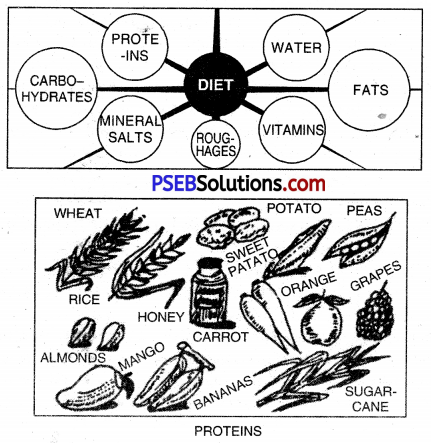
(ii) Rickets or Rachitis:
As a result of the lack of proteins children suffer from rachitis. A child affected with this disease looks very thin and weak. Bones are visible through his flesh.
(iii) Hunger Oedema:
Because of prolonged hunger and lack of protein, the body does not get nourishment, and water gets accumulated in cells, and body appears to be swelled up.
(iv) Pellagra:
As a result of this disease, one’s skin appears to be rough and dry.
(v) Defect in the Liver:
Liver gets damaged due to the lack of protein in food.
Harms of the Excess of Proteins:
One may suffer from kidney ailments in case of excessive intake of proteins. Blood vessels too get affected, and one begins to have joint pains.
Proper Quantity:
Children in the age group of 1-6 years are in dire need of proteins in large amounts. A normal person should consume 70 to 100 gms. of proteins everyday.
2. Carbohydrates:
Carbohydrates provide heat and energy to the body. Indians, in general, compensate 70-80% of their food with this compound.
Sources:
Carbohydrates are available in wheat, rice, barley, maize, millet, jaggery, sugar, potatoes, etc.
Advantages of Carbohydrates:
- Carbohydrates provide heat and energy to the body.
- They help in digesting fat.
- They cleanse intestines and liver.
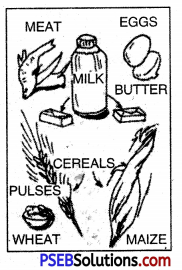
Harms Due to Lack of Carbohydrates:
- As a result of the lack of carbohydrates, blood loses its alkaline nature, and becomes more acidic. In such a condition, a person may become unconscious. In such a condition due to hunger one may get diabetes.
- Intestines are not cleansed properly.
- As a result of lack of carbohydrates, fats remain undigested in the body.
- As a result of lack of carbohydrates acidic elements in the liver get cleansed, and it is harmful to the body.
- A person becomes very weak and may die in case there is excess of lack of carbohydrates in his food.
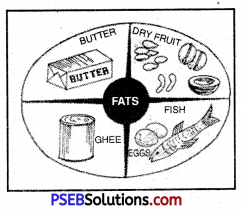
Harms due to Excess of Carbohydrates:
The excess of carbohydrates causes
- fatness
- high blood pressure
- joint pains, and
- diabetes.
Proper Quantity:
Our food has 50-80% of carbohydrates, 50-60% part of balanced diet consists of carbohydrates. A normal person should have 400 to 700 gms. of carbohydrates in his daily food.
3. Fats:
Fats are of two types:
- vegetable fats
- animal fats.
Sources:
- Vegetable Fats:
These are available in almonds, walnuts, soyabeans, groundnuts, coconut oil, mustard etc. - Animal Fats .
These are available in ghee, butter, milk, meat, fish, egg, etc.,
Advantages:
- It provides energy to the body.
- It keeps the body temperature stable.
- It protects all parts of the body against external injuries.
- It keeps in reserve vitamins A, D and K according to the needs of the body.
Harms due to the Lack of Fats:
The bod suffers in the following ways in case there is lack of fats :
- Skin becomes dry.
- The deficiency of vitamins A, D and K follows.
- The skin goes dry because of the lack of acids of fat.
Harms due to the Excess of Fats:
The excess of fats in one’s food also proves to be harmful in the following ways:
- One suffers from obesity.
- Heart diseases are caused.
- Digestion weakens.
- One suffers from diabetes.
- Stones may form in the abdomen.
Proper Quantity:
A normal person should have 50 to 75 gms. of fats in his daily food.
4. Mineral Salts:
Our body has 4% of minerals and salts. Phosphorus, calcium, sodium, chlorine.
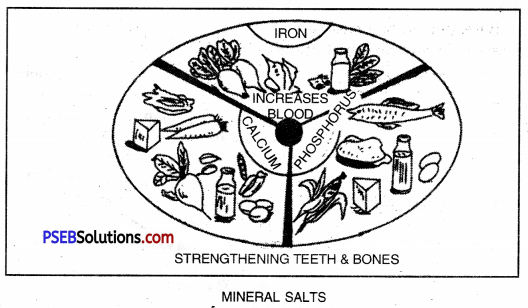
Potassium, magnesium, manganese, iodine and zinc are some prominent minerals.
Sources:
Minerals and salts are available in green vegetables, green fruit, meat, milk. Milk has less amount of iron, but it has all other minerals.
Advantages:
- Minerals strengthen our teeth and bones.
- They help in the development of muscular tissues.
- They make the blood red.
- Calcium helps in blood clotting.
- Minerals help in the proper functioning of all parts of the body.
1. Calcium and Phosphorus:
These minerals are found in abundance in milk, curd, cheese, eggs, fish, meat, vegetables, fresh fruit, pulses, almonds, etc. They are helpful in the growth of body. They help in formation of teeth and bones. They are useful to heart and brain.
2. Iron:
Iron is available mostly in green vegetables, fruit, cereals, eggs and meat. It helps in producing new iron and stimulates hunger. It cleanses blood.
3. Sodium:
It is generally available in lady fingers, fig, coconut, salt, radish, carrot, turnip, etc. It removes many diseases of stomach and kidneys.
4. Potassium:
It is available in pear, coconut, lemon, fig, cabbage, radish, etc. It nourishes liver and heart, and removes constipation.
5. Iodine:
It is available in sea fish, sea salt, onion, garlic, tomato, apple, spinach, carrot and milk, etc. It give energy and increases body weight.
6. Mangesium:
It is available mostly in orange, fig, tomato, wheat, spinach, malta, etc. It prevents skin diseases and strengthens muscles.
7. Sulphur:
It is available in plenty in onion, radish, cabbage, cauliflower. It helps increase nails and hair. It cleanses skin.
8. Chlorine:
It is available in plenty in onion, spinach, radish, carrot, cabbage and tomato. It excretes waste products from the body. It cleanses the body.
9. Water:
Our body is composed of 2/3rd of water. It is formed of the combination of oxygen and hydrogen. It is as important as air for our body.
Sources:
It is available in pure form in many nutrients also such as milk, fruit and vegetables.
Advantages of Water
- Water helps in the formation of cells.
- It carries nourishment to cells. It helps in the excretion of waste products from the body.
- It helps in digestion of food.
- It regulates the heat in our body.
- It helps in mixing nutrients with blood. .
- It keeps the parts and joints of body soft.
- It ensures blood circulation in the body.
Harms due to Lack of Water in the Body:
There are many harms of drinking less water:
- The food does not digest properly in case one drinks less water.
- Liver remains heavy.
- Constipation is caused.
- One feels physical fatigue all the time.
- The body gets weakened.
- The face turns pale.
- Waste products in the body do not get excreted properly.
- One is afflicted with joint pains.
- Stones are formed in kidneys.
Harms due to Excess of Water:
Water should always be taken in right proportion. Liver remains filled by taking water in excess and one does not feel appetite. If one continues taking water with food, food does not digest properly.
Proper Quantity:
The quantity of water intake varies with season, exercise and food. Normally, 5-6 glasses of water are enough for a normal person.
6. Vitamins:
By now many vitamins have been discovered, but the most prominent of all these are vitamins, A, B, C, D, E and K. The details about the sources and functions of various vitamins have been given below :
(i) Vitamin A:
The following are the functions of vitamin A:
- It improves eyesight.
- It increases appetite.
- It keeps digestive function normal.
- It helps in the development and strengthening of body.
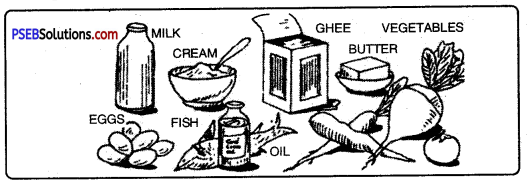
The lack of vitamin A causes night blindness.
- The skin becomes dry.
- Nose, thorat, eyes skin become more prone to infectious diseases.
- The body becomes weak and its development stops.
- The lungs get weakened.
Sources:
It is available in plenty in milk, curd, butter, cheese, egg, fish, fresh vegetables such as spinach, carrot, cabbage and ’ tomato, orange, mango, papaya fig, etc.
(ii) Vitamin B:
The following are the functions of Vitamin B –
- It regulates nervous system and keeps it normal.
- It energizes nerves, muscles, heart and brain.
- It stimulates appetite.
- It gives protection against skin diseases.
Harms due to Lack of Vitamin B:
- One feels less appetite.
- The development of children stops.
- One is afflicted with a disease called beri-beri and skin diseases.
- One develops blisters on the tongue.
- The hair begins to fall off.
Sources:
It is available in milk, curd, butter, cheeses, whole pulses, cereals, soyabean, peas, eggs, leaves of green vegetables, cabbage, onion, spinach, tomato, salad, etc.
(iii) Vitamin C:
The functions of vitamin C are :
- It purifies the blood.
- It strengthens teeth.
- It helps in the rapid recovery of fractured bones
- It protects the body againstdiseases
- It saves throat from several diseases.
- It protects one from bad cold Sources, etc.
Harms due to Lack of Vitamin C:
- One is afflicted with such teeth diseases as pyorrhoea.
- The bones get weakened.
- Wounds do not heal quickly.
- One suffers from anaemia.
- Bleeding does not stop quickly.
![]()
Sources:
It is found in orange, lemon, malta, pomegranate, guava, amla, etc. In addition to these, it is available in green vegetables, tomato, cabbage, carrot, spinach, etc.
(iv) Vitamin D:
The functions of Vitamin D are :
1. It helps in the formation of bones and teeth.
2. It strengthens bones and teeth.
3. It is needed most for the growth of children.
Sources.
It is found in milk, egg yolk, butter, ghee, cod liver oil, etc. It forms itself in the rays of the sun.
Harms due to Lack of Vitamin D:
- Bones become weak.
- The teething of children gets delayed.
- One is afflicted with such diseases as epilepsy, hysteria and rickets.
- Muscies become weak
(v) Vitamin E:
The functions of vitamin E are :
- It increases the reproduction power.
- It prevents impotency,in men and infertility in women.
Harms due to Lack of Vitamin E:
- Boils are found on the skin.
- One is afflicted with infertility.
Sources:
It is available in cabbage, carrot, salad, peas, onion, tomato, cauliflower. In addition to these, it is found in honey, wheat, rice, egg yolk, almond, pistachio, gram, pulse, etc.
(vi) Vitamin K:
The functions of Vitamin K are as follows :
- It helps in blood clotting.
- It saves one from skin diseases.
Harms due Lack of Vitamin K:
- The process of blood clotting gets stopped.
- One is afflicted with some skin diseases.
Sources:
It is found in cabbage, spinach, fish, soyabean, tomato and egg yolk.
![]()
Question 2.
How many calories should a normal player take?
Answer:
Porper Quantity of Diet for a player –
The following is the proper quantity of diet for a normal player Porper:

Question 3.
Milk is a complete diet. Discuss.
Answer:
Milk:
Milk is an ideal and whole food. It has got all the essential nutrients. It has 3.6% fat, 3.4% protein, 4.8% carbohydrates,0. 7% salts and 7.5% water. Milk is given to growing children because it is a complete food. At home patient is also given milk which acts as complete food.For good health milk serves as balanced diet.
All the essential nutrients as portein, carbohydrates, fat, minerals, salts, water,vitamins are available in milk in right proportion. All these nutrients have different functions to perform in our body. Milk is considered to be an ideal food as it has all the essential nutrients including vitamins, though it does not have iron.
Question 4.
Write down important Rule for taking food.
Answer:
Important Rules for Taking Food
We must follow some essential rules if we want to make the best use of the food we eat. These rules are as follows :
- Food must be taken at fixed time.
- Hands should be properly washed before eating food.
- Food must be eaten slowly, and chewed properly.
- At the time of taking food one should refrain from reading anything or talking to somebody else.
- One should remain cheerful. One should stop worrying.
- Food should be taken when one is hungry.
- Food must be taken according to need. Neither should it betaken less nor in excess.
- Fried eatables are not easily digested. So fried things should be used sparingly.
- Stale or bad food is harmful to health.
- Rest for some time after taking noon-time food (lunch) is beneficial to health.
- Food should be taken 2 hours before one goes to bed. It is harmful to sleep immediately after taking dinner.
- Doing exercise immediately after taking food is harmful.
- One should avoid taking cold water immediately after taking food.
- Teeth should be properly rinsed and brushed after taking meal, otherwise small pieces of food remain stuck in bet ween teeth, and one suffers from many tooth diseases and bad odour.
- The place where one takes food should be clean.
- Extremely hot and spicy food is harmful to health.
- Food should be kept covered.
- There should be variety in food items.
- Excessively sweet or sour things should be avoided.
- Water should always be taken during the taking of one’s meal.
- Food should be properly cooked.
![]()
Question 5.
Why do we cook food? What are the various methods of cooking food?’Discuss which is the best.
Answer:
Need for Cooking Food. Properly cooked food is useful for health, Food must be cooked properly. If food is over-cooked, it loses some essential nutrients like vitamins C and D. Food must be cooked for the following reasons:
- Properly cooked food becomes easily digestible.
- By cooking food disease germs get killed.
- Cooked food is tasty. One feels like eating it.
- We can preserve the cooked food for long.
Methods of Cooking Food:
The following methods for cooking are generally followed :
- Boiling
- Cooking with steam
- Roasting
- Frying.
These methods are explained in brief below :
1. Boiling:
In this method, food articles are cooked by boiling in water. But essential vitamins and mineral salts dissolve in water
and are lost in this method of cooking. A little quantity of water should be used in boiling eatables. If water used in boiling is excessive, it should not be thrown. Rice, pulses, meat and vegetables are cooked by boiling.
2. Cooking with Steam:
Food is also cooked with steam. Essential nutrients do not lost in cooking by this method. The food cooked in a steam cooker is nutritious and beneficial to health. So, this method is considered to be better than other methods.
3. Roasting:
In this method, food is directly roasted on the fire. Excessive roasting also destroys essential nutrients. The roasted meat is tasty and easily digestible.
4. Frying:
There are many food items such a ‘pakora’, ‘samosa’ and “puriran” which are fried. Food is cooked very soon by frying. But essential nutrients also lost in this method. Moreover, fried food is not easily digestible, and is often harmful to one’s health. Best Method. Of all the methods of cooking, cooking with steam is the best. The food cooked in this way does not lose essential nutrients, and it is very beneficial to one’s health.